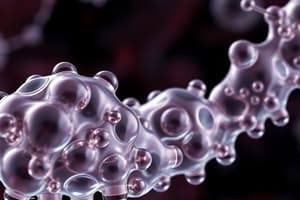Podcast
Questions and Answers
What characteristic of phospholipids allows them to form micelles in aqueous environments?
What characteristic of phospholipids allows them to form micelles in aqueous environments?
- They contain multiple phosphate groups.
- They consist of only fatty acids.
- They are amphipathic. (correct)
- They are completely nonpolar.
Which component is NOT part of the structure of phospholipids?
Which component is NOT part of the structure of phospholipids?
- Phosphate group
- Polar head
- Three fatty acids (correct)
- Glycerol backbone
What is the function of cholesterol in cell membranes?
What is the function of cholesterol in cell membranes?
- To act as a signaling molecule.
- To form protective barriers.
- To provide energy storage.
- To regulate membrane fluidity and stability. (correct)
Which type of phospholipid contains an ethanolamine group?
Which type of phospholipid contains an ethanolamine group?
What is the primary structural feature of steroids?
What is the primary structural feature of steroids?
Which type of fatty acid contains no double bonds between the carbon atoms?
Which type of fatty acid contains no double bonds between the carbon atoms?
What is the primary product of the saponification reaction?
What is the primary product of the saponification reaction?
Which of the following best describes a triacylglycerol?
Which of the following best describes a triacylglycerol?
What is the role of a catalyst, such as H2SO4, in the esterification process?
What is the role of a catalyst, such as H2SO4, in the esterification process?
What type of lipids are characterized by having fatty acids with at least one double bond?
What type of lipids are characterized by having fatty acids with at least one double bond?
Which of the following fatty acids is classified as a saturated fatty acid?
Which of the following fatty acids is classified as a saturated fatty acid?
What is an example of an insaponifiable lipid?
What is an example of an insaponifiable lipid?
What does the term 'cis' refer to when describing fatty acids?
What does the term 'cis' refer to when describing fatty acids?
Flashcards
Saturated fatty acid
Saturated fatty acid
A fatty acid with all carbons saturated with hydrogen atoms.
Unsaturated fatty acid
Unsaturated fatty acid
A fatty acid with at least one double bond in the carbon chain.
Esterification
Esterification
A reaction that forms triacylglycerol (a type of fat) by combining glycerol and fatty acids.
Saponification
Saponification
Signup and view all the flashcards
Triacylglycerol
Triacylglycerol
Signup and view all the flashcards
Fatty Acid
Fatty Acid
Signup and view all the flashcards
Glycerol
Glycerol
Signup and view all the flashcards
Lipids
Lipids
Signup and view all the flashcards
Phospholipid Structure
Phospholipid Structure
Signup and view all the flashcards
Phospholipid Function
Phospholipid Function
Signup and view all the flashcards
Steroid Structure
Steroid Structure
Signup and view all the flashcards
Cholesterol Function
Cholesterol Function
Signup and view all the flashcards
Cell Membrane Structure
Cell Membrane Structure
Signup and view all the flashcards
Study Notes
Lipids
-
Lipids are classified into simple and complex, based on whether they contain saponifiable fats or not.
-
Simple lipids contain fatty acids. Complex lipids lack fatty acids.
-
Under "Simple" are subclasses:
- Acilglycerols
- Waxes
-
Under "Complex" are subclasses:
- Phospholipids (phosphoglycerides, sphingolipids, and glycosphingolipids)
- Isoprenoids (terpenes and steroids)
- Prostaglandins
Fatty Acids
-
A saturated fatty acid contains no double bonds in the hydrocarbon chain.
-
An unsaturated fatty acid contains one or more double bonds in the hydrocarbon chain.
- Cis fatty acids contain carbon-carbon double bonds where H atoms are on the same side of the double bond.
- Trans fatty acids contain carbon-carbon double bonds where H atoms are on opposite sides of the double bond.
-
Examples of fatty acids:
- Stearic acid
- Oleic acid
- Linoleic acid
-
The chemical formula for saturated fatty acids shows a long chain with -CH2- groups between the terminal methyl (-CH3) end and the terminal carboxyl group (-COOH).
-
The chemical structure shows angles of 110° between carbon atoms.
Esterification and Saponification
- Esterification is the reaction between an acid and an alcohol, producing an ester and water.
- Saponification is the reverse reaction, breaking down an ester into an acid and an alcohol using a base (e.g., sodium hydroxide).
Triglycerides
- Triglycerides are formed when glycerol reacts with three fatty acids via esterification.
Phospholipids
- Phospholipids are complex lipids containing a phosphate group.
- Phospholipids in a cell membrane have hydrophobic tails and hydrophilic heads.
Steroids
- Steroids like cholesterol have a fused ring structure .
Examples from the diagrams:
-
Colesterol and Estradiol are steroids with complex ring structures.
-
Acid Palmític, Acid Esteàric, Acid Oleic and Acid Linoleic are fatty acids found in diagram .
-
Phosphatidylethanolamine, Phosphatidylserine, Phosphatidylcholine, and Sphingomyelin are examples of phospholipids.
Fats vs Oils
- Fats are typically solid at room temperature and are usually saturated fatty acids.
- Oils are typically liquid at room temperature and are usually unsaturated fatty acids.
Soap Production
- A process of using a base (sodium hydroxide or potassium hydroxide) to convert lipids (e.g., olive oil) into soap are shown in the diagrams.
Studying That Suits You
Use AI to generate personalized quizzes and flashcards to suit your learning preferences.




